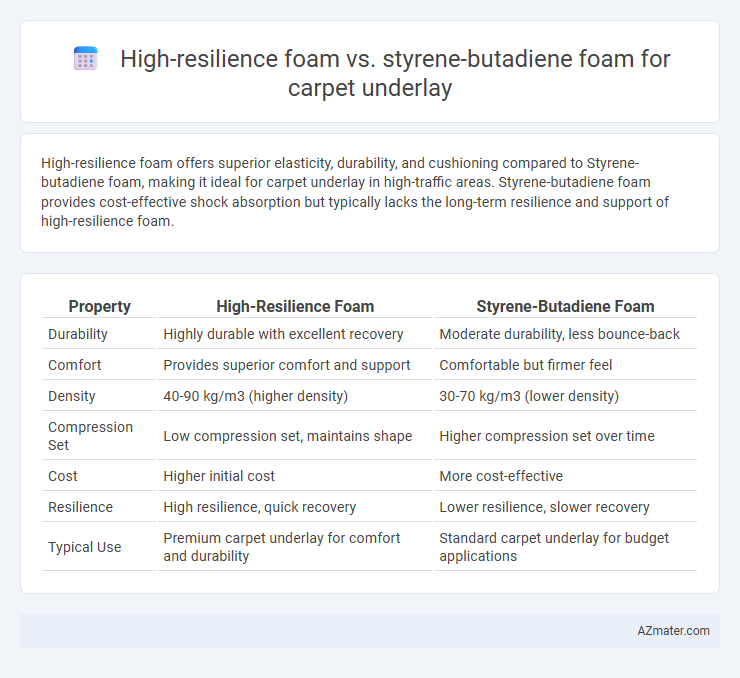High-resilience foam offers superior elasticity, durability, and cushioning compared to Styrene-butadiene foam, making it ideal for carpet underlay in high-traffic areas. Styrene-butadiene foam provides cost-effective shock absorption but typically lacks the long-term resilience and support of high-resilience foam.
Table of Comparison
| Property | High-Resilience Foam | Styrene-Butadiene Foam |
|---|---|---|
| Durability | Highly durable with excellent recovery | Moderate durability, less bounce-back |
| Comfort | Provides superior comfort and support | Comfortable but firmer feel |
| Density | 40-90 kg/m3 (higher density) | 30-70 kg/m3 (lower density) |
| Compression Set | Low compression set, maintains shape | Higher compression set over time |
| Cost | Higher initial cost | More cost-effective |
| Resilience | High resilience, quick recovery | Lower resilience, slower recovery |
| Typical Use | Premium carpet underlay for comfort and durability | Standard carpet underlay for budget applications |
Introduction to Carpet Underlay Materials
High-resilience (HR) foam offers superior durability and excellent cushioning compared to styrene-butadiene (SB) foam, making it ideal for carpet underlay applications. HR foam's open-cell structure provides enhanced breathability and resilience, extending carpet life by reducing wear and improving comfort. In contrast, SB foam, known for affordability and moisture resistance, may compress more quickly under heavy traffic, affecting long-term performance.
What is High-Resilience Foam?
High-resilience foam is a durable, supportive material made from polyurethane, known for its ability to retain shape and provide superior cushioning under carpets. This foam features a higher density and faster rebound rate compared to Styrene-butadiene foam, enhancing comfort and longevity in underlay applications. Its open-cell structure allows better air circulation, contributing to moisture resistance and improved indoor air quality.
What is Styrene-Butadiene Foam?
Styrene-Butadiene Foam is a synthetic rubber material known for its excellent cushioning and shock absorption properties, commonly used in carpet underlays to enhance comfort and durability. It offers good resistance to abrasion and maintains consistent performance under heavy foot traffic. This foam type provides a cost-effective alternative to high-resilience foam, balancing affordability with adequate support for residential and commercial flooring applications.
Durability Comparison: High-Resilience vs Styrene-Butadiene Foam
High-resilience foam offers superior durability compared to styrene-butadiene foam, maintaining its shape and cushioning properties over extended periods under heavy foot traffic. Styrene-butadiene foam tends to compress and degrade faster, reducing its lifespan and support efficiency in carpet underlays. This makes high-resilience foam the preferred choice for long-term performance and resilience in flooring applications.
Comfort and Cushioning Properties
High-resilience foam offers superior comfort and cushioning for carpet underlay due to its excellent elasticity and ability to quickly regain shape, providing long-lasting support and reducing foot fatigue. Styrene-butadiene foam, while cost-effective and moisture-resistant, has lower resilience and tends to compress more quickly, resulting in diminished comfort over time. Selecting high-resilience foam enhances carpet durability and provides a premium cushioning experience ideal for high-traffic areas.
Insulation and Soundproofing Performance
High-resilience foam offers superior insulation properties due to its open-cell structure, enhancing thermal resistance and maintaining room temperature efficiently. Styrene-butadiene foam, while also effective in sound absorption, typically provides denser cushioning that better dampens impact noise and reduces sound transmission. For carpet underlay, high-resilience foam excels in thermal insulation, whereas styrene-butadiene foam is often preferred for enhanced soundproofing performance.
Environmental Impact and Sustainability
High-resilience (HR) foam, derived primarily from polyurethane, offers superior durability and longer lifespan in carpet underlay applications, reducing waste and frequency of replacement. Styrene-butadiene rubber (SBR) foam, synthesized from petroleum-based styrene and butadiene, presents challenges in biodegradability and contributes to microplastic pollution during degradation. HR foam's potential for recycling and lower emissions during production makes it a more sustainable option compared to the higher carbon footprint and limited recyclability associated with SBR foam.
Cost Analysis and Value for Money
High-resilience foam offers superior durability and support compared to styrene-butadiene foam, often leading to a higher upfront cost but extended lifespan and better overall value for money. Styrene-butadiene foam tends to be more affordable initially but may require more frequent replacement due to faster compression and wear, increasing long-term expenses. Evaluating total cost of ownership, high-resilience foam provides a cost-effective solution for those prioritizing performance and longevity in carpet underlay.
Ideal Applications for Each Foam Type
High-resilience foam offers superior durability and elasticity, making it ideal for high-traffic areas and commercial carpet underlays where long-term support and comfort are essential. Styrene-butadiene foam provides excellent cushioning and moisture resistance, which suits residential spaces and environments prone to humidity. Selecting the appropriate underlay depends on balancing factors such as foot traffic, comfort preferences, and environmental conditions.
Conclusion: Choosing the Right Carpet Underlay
High-resilience foam offers superior durability, excellent support, and enhanced comfort, making it ideal for high-traffic areas and long-term use. Styrene-butadiene foam provides effective cushioning with good moisture resistance and affordability, suitable for budget-conscious projects or moderate foot traffic. Selecting the right carpet underlay depends on balancing performance needs, lifespan expectations, and cost considerations to optimize flooring comfort and durability.

Infographic: High-resilience foam vs Styrene-butadiene foam for Carpet underlay
 azmater.com
azmater.com